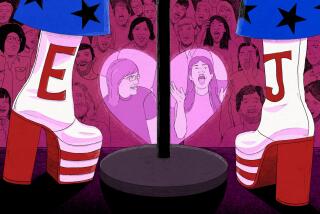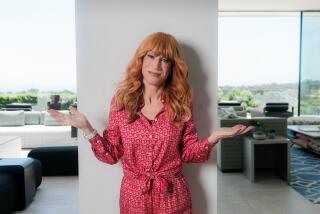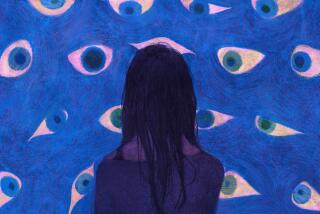Being Different: A Personal Story of Thalidomide
WASHINGTON — I am the daughter whose presence on the delivery table would have devastated most mothers. Imagine the scenario:
“Mrs. Smith,” the doctor says, “you have a baby girl.”
“Is she pretty?” Mrs. Smith asks. “Can I hold her?”
The doctor stammers, “Mrs. Smith, your baby is missing most of her legs.”
The doctor gives the mother a tiny infant whose right leg is missing from a point just above the place where a knee might have been and whose left leg has a knee with only a small, underdeveloped portion of a lower calf extending from it.
This is what my body resembled at birth--and still does. Yet I would not choose any other life.
My story begins between the 26th and 60th day after I was conceived. On approximately the 28th day, we develop limb buds; this was true in my case. Usually the entire limb is developed by the 56th day; in my case, the development was hindered. The agent that caused this was most likely Thalidomide.
Thalidomide was a drug used by thousands of pregnant women in Europe as a sedative. It was banned in the United States, but did make its way into this country through one company. About 20 Thalidomide cases were reported in the United States, according to a London Times task force, and more than 8,000 cases in Europe. The drug was withdrawn from the world market in 1962.
The results of this chemical have been described as “monstrosities.” And there were monumental lawsuits brought by parents. In addition, a number of abortions were also performed on women who were informed of the possibilities.
My mother vaguely remembers being given a drug while on a trip to Germany because she was experiencing nausea and restlessness from her pregnancy. For my parents, abortion was not an option, even had they been aware of my condition. They believe that it was God’s decision, and they were content with that decision. For this same reason, they did not pursue any legal action. For them, a lawsuit never would have addressed the issue.
Their belief has led me to accept--even prefer--things for what they are. Many people may find this difficult to believe. They feel lucky that amniocentesis is available to screen out babies born with less severe deformities than mine. The thought frightens me.
Amniocentesis could never have told my mother that I would have artistic talent, a high intellectual capacity, a sharp wit and an outgoing personality. The last thing amniocentesis would tell her is that I could be physically attractive.
My point is that we demean the value of an individual’s worth by adhering to a medical label such as “disabled.” What is worse, most medical professionals aren’t even aware of the attitude they may convey to prospective parents--that a disabled life is not worth living.
Most people do not believe me when the subject comes up and I tell them that I have artificial limbs. Unless I were to wear miniskirts, which I don’t, my physical differences would not be apparent. I limp, but not as much as some people think I should.
I take off my legs to go swimming. On the surface, I suddenly appear very disabled, but I can actually swim better than most people. I have learned to live with this frequent dissonance between the image I have of myself and the one that others reflect back to me. My task has been to integrate these images.
In kindergarten I asked for the first time, “Why don’t I have legs?”
“Because God looked for someone to love extra special. He chose you to be that person and to carry the cross,” one nun explained. But sometimes I suspected that other people thought I must have done something very wicked in a past life to receive such a severe punishment.
What I feel I needed to hear again and again in my childhood is something like, “You’re different. We’re not sure why. There isn’t anything we can do about it. We love you very much, and we’re glad that you’re here.”
Normal Life
To help me lead a normal life, my parents taught me never to underestimate my capabilities. They sent me to the same schools as my 10 brothers and sisters, expected me to fulfill the same responsibilities and to lead a similar life.
At the same time that I competed with other children in school, sports and social situations, my parents also tried to tell me about my limitations. Their statements were blasphemy to my ears. I begged them to let me play softball and take ballet lessons. Usually after a reasonable trial period, I would find some excuse to quit.
I quit ballet after two years to free up my schedule for softball, and also because ballet was for sissies. Two years later, I quit softball because I was going to high school, and I heard that high school boys did not like girls who played softball.
Being different was an idea that never did quite settle into my mind.
Once when I asked my mother why some boys were taunting me about my legs, her eyes filled with tears. “You know I would give you my legs, if I could,” she said.
I walked away feeling intensely guilty.
“I don’t want to take her legs from her,” I thought, and then for a moment I envisioned what it might be like if I could take her up on the offer. “No,” I concluded, “they would be too big for me.”
My fantasy wasn’t too far from reality. People had begun to talk about transplanting body parts. Why not legs? I began to dream about it.
I dreamed once that I had the transplant and danced my way to the head of the American Ballet Theatre. But then the legs started to rot right off my body.
I had another nightmare. The transplant was performed but when I lifted up my sheets I saw a pair of men’s legs attached to my tiny body. I tried to make the best of them in my dream, and I kept shaving them to make them look nice and smooth, but the hair just grew back, darker and coarser than before.
When I started first grade, recess was my worst trial. I would head out to the uncharted parts of the playground, bypassing hopscotchers, superball chasers and rope jumpers until I came to the edge of the brick wall where the playground ended.
Wander Aimlessly
Finally, I would turn back and wander aimlessly through the crowd of children, until someone would finally speak to me. “Please hold the end of our jump rope, while Theresa goes to the lavatory,” some girls asked me once.
Finally, I began to make acquaintances on the playground. I also began to make enemies. It seemed the very minute that someone had taken notice of me, someone else felt compelled to ask, “Why does that girl have those things on her legs?” From the wrong mouth, that question was deadly.
Gordie Schultz was the one to peg me “Walky-Talky.” I didn’t like Gordie, and I particularly resented his intrusions into my role as the part-time jump-rope flipper.
One day someone forgot to bring the rope. Frustrated, I began to wander. Gordie followed me, popping up from behind a stairwell or dumpster to shout “Walky-Talky” and then run. I kept walking, and I grew angry that I couldn’t run from him. When I found myself with nowhere else to go, I turned a corner and simply leaned my shoulder against the building wall, fighting off tears.
Suddenly Gordie was at my back. “Walky-Talky,” he whispered. Before I knew it, I had turned around to face him as my right hand, clinging to my metal lunchbox, came barreling down on his nose. I heard his wailing even after he rounded the corner.
Life continued to present me with a new challenge at every turn. Dating, parties and high-school proms were all experiences that I remember fondly. I had mastered the art of turning failure into folly.
Freshman Year
Yet, just as I began to believe that I had conquered this thing called disability, I learned that it was not a thing to be conquered. Rather, it was something to accept.
I lived in a sorority house in college. Freshman year, a few of us would gather at night to have cocktails, gossip, play games or swap tales of our youths.
Inevitably, I was called upon to tell the one about how my leg fell off at the skating rink when I was 10, or how it wouldn’t fit into the car on the roller coaster when I was 12. I deftly executed the stories, adding more detail each time, and savoring each measure of denouement.
One night, I began to tell one of my stories, but it didn’t come out funny. I found myself sobbing uncontrollably to a chubby sophomore. She seemed very understanding. I trusted her until the next day, when I learned that others knew about the incident.
Suddenly, people seemed apprehensive around me. A few days later, I ran into a guy whom I dated in high school. “When did you decide that it wasn’t funny anymore?” he asked peevishly.
I began to believe that if what I had to say wasn’t funny, they didn’t want to hear about it. A long time went by before I could tell a funny story on myself again.
After college, I entered a master’s program in rehabilitation counseling at Boston University. I wanted to understand how medical issues could mold a life. I wanted to understand myself.
I worked part-time in research, interned with the Psychology Service at New England Regional Spinal Cord Injury Center and carried a full course load. My internship on the spinal-cord unit became the center of my life.
My patients, mostly males about 21 years old, were paralyzed as the result of such tragedies as gunshots, failed suicide attempts and sports accidents. I was also 21 and enjoyed the same bands, books and music.
My presence seemed to bring out the tensions in my patients. “On the floor, you are a walking Rorschach,” one supervisor told me.
At night I would go home and feel my patients’ anger festering inside of me. I would write letter after letter, sending only those that I believed would help the people closest to me to sense my pain. I cursed the world for building an impenetrable wall between able bodies and disabled ones, arguing with anyone who would dare to admit “disabled people do make me uncomfortable.”
Paul Was the Difference
Then I met Paul. He and I dated about two years before we got married last fall. We spent part of one summer traveling through five countries in Europe, often on foot. At times I simply threw myself down on the curb. I would look up at him, furiously shaking my head, and he would stand there, patiently extending his hand. “Come on,” he would say in his soothing tone, and then add, “You big baby.”
Paul is studying at the Georgetown Law Center in the evening division while working full-time in the Department of Justice. I have gone back to school in Howard University’s graduate program in clinical psychology and work for a private rehabilitation firm. It will be three years before Paul graduates and 4 1/2 for me.
We are just beginning to think seriously about children, something we both want very much, but we have too many commitments to give a child the attention that it deserves.
When we do have children, our chances of having a disabled child are probably no greater than most people’s. My mother had six healthy babies before me and four healthy ones after me. I want to get some consultation before we try to have children. It is important to me to consider all the ramifications of my decision. I still have to contend with the physical and emotional impact of motherhood, as well as the risks of deformity in the child. I feel confident that Paul and I will work this out.
As far as the emotional side of things is concerned, I will have to deal realistically with a child who might at times feel embarrassed by my physical differences.
It will be difficult, but I have learned to understand others’ discomfort and curiosity about my differences. Most importantly, I look forward to teaching my child to love himself or herself in ways that most children will never have a chance to learn.
More to Read
Sign up for Essential California
The most important California stories and recommendations in your inbox every morning.
You may occasionally receive promotional content from the Los Angeles Times.










